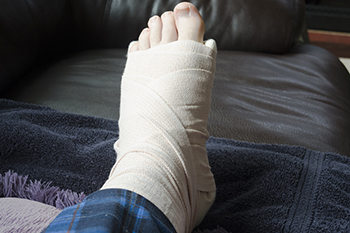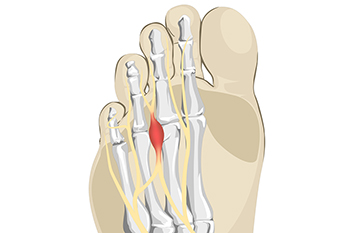Items filtered by date: May 2023
Risk Factors for Spraining an Ankle

Ankle sprains are a common injury for people who are active in sports, but they also can happen to anyone. Certain behaviors put a person at more risk for this type of injury. A typical risk factor is embarking on strenuous physical activity when your body is not in shape. Another is pushing through muscle and ligament fatigue, toward the end of a run for instance, rather than resting for a little while before continuing. A third risk factor for ankle sprains is not warming up thoroughly before an activity. This causes tight muscles and ligaments to be more likely to tear. Carrying extra weight is another contributor to the likelihood of spraining an ankle, because of an increased load on the joint. Ill-fitting or inappropriate footwear is another factor. This applies in ordinary life, such as walking on slippery surfaces in high heels, not just during athletic endeavors. Anyone who has previously sprained an ankle is at more risk of incurring another such injury. Making sure the previously injured ankle has completely healed before resuming activity can help to prevent this. For more information on ankle sprains, it is suggested that you contact a podiatrist.
Although ankle sprains are common, they aren’t always minor injuries. If you need your ankle injury looked at, contact Dr. John P. Beaupied from Palos Podiatry. Our doctor can provide the care you need to keep you pain-free and on your feet.
How Does an Ankle Sprain Occur?
Ankle sprains are the result of a tear in the ligaments within the ankle. These injuries may happen when you make a rapid shifting movement while your foot is planted. A less common way to sprain your ankle is when your ankle rolls inward while your foot turns outward.
What Are the Symptoms?
- Pain at the sight of the tear
- Bruising/Swelling
- Ankle area is tender to touch
- In severe cases, may hear/feel something tear
- Skin discoloration
Preventing a Sprain
- Wearing appropriate shoes for the occasion
- Stretching before exercises and sports
- Knowing your limits
Treatment of a Sprain
In many cases, the RICE method (Rest, Ice, Compression, and Elevate) is used to treat ankle sprains. However, you should see a podiatrist to see which treatment option would work best with your injury. In severe cases, surgery may be required.
It is important to ask your doctor about rehab options after you receive treatment for your injury. Stretching, strength training, and balance exercises may help the ankle heal while also preventing further injury.
If you have any questions, please feel free to contact our office located in Palos Heights, IL . We offer the newest diagnostic and treatment technologies for all your foot care needs.
Toe Pain at Night

Some people experience pain, cramping, or numbness in their toes at night. Prolonged time on the feet, dehydration, wearing ill-fitting shoes, and mineral deficiencies can trigger this type of pain. Overexertion can drain minerals from the body through sweat and cause cramps in the toes. Wearing shoes that do not fit well can restrict blood flow to the toes. People over age 50 and women who have entered menopause can lose calcium in their bones, which can cause toe cramping during the night. Other medical conditions, including arthritis, peripheral neuropathy, and gout, can result in the same symptoms. If you are experiencing persistent toe pain during the night, it is suggested that you seek counsel from a podiatrist who can evaluate what might be going on and provide appropriate treatment.
Toe pain can disrupt your daily activities. If you have any concerns, contact Dr. John P. Beaupied of Palos Podiatry. Our doctor can provide the care you need to keep you pain-free and on your feet.
What Causes Toe Pain?
Most severe toe pain is caused due to a sports injury, trauma from dropping something heavy on the toe, or bumping into something rigid. Other problems can develop over time for various reasons.
Toe pain can be caused by one or more ailments. The most common include:
- Trauma
- Sports injury
- Wearing shoes that are too tight
- Arthritis
- Gout
- Corns and calluses
- Hammertoe
- Bunions
- Blisters
- Ingrown toenails
- Sprains
- Fractures (broken bones)
- Dislocations
When to See a Podiatrist
- Severe pain
- Persistent pain that lasts more than a week
- Signs of infection
- Continued swelling
- Pain that prevents walking
Diagnosis
In many cases the cause of toe pain is obvious, but in others, a podiatrist may want to use more advanced methods to determine the problem. These can range from simple visual inspections and sensation tests to X-rays and MRI scans. Prior medical history, family medical history, and any recent physical traumatic events will all be taken into consideration for a proper diagnosis.
Treatment
Treatments for toe pain and injuries vary and may include shoe inserts, padding, taping, medicines, injections, and in some cases, surgery. If you believe that you have broken a toe, please see a podiatrist as soon as possible.
If you have any questions please feel free to contact our office located in Palos Heights, IL . We offer the newest diagnostic tools and technology to treat your foot and ankle needs.
Acute Metatarsal Fracture

When an individual breaks or fractures their foot, it is important to note which kind of fracture has developed. For example, one important kind of foot fracture is known as an acute metatarsal fracture. This can occur after a sudden and forceful blow to the feet, from a sports injury, or from kicking a heavy object. Importantly, acute metatarsal fractures are divided up into four different major classifications. There are open fractures, closed fractures, displaced fractures, and not displaced fractures. What makes a fracture open is when the skin is broken over the fractured bone. Also, what makes a fracture displaced is that the bones have slipped out of alignment. If you are suffering from a broken foot, it is suggested that you schedule an appointment with a podiatrist today for treatment.
A broken foot requires immediate medical attention and treatment. If you need your feet checked, contact Dr. John P. Beaupied from Palos Podiatry. Our doctor can provide the care you need to keep you pain-free and on your feet.
Broken Foot Causes, Symptoms, and Treatment
A broken foot is caused by one of the bones in the foot typically breaking when bended, crushed, or stretched beyond its natural capabilities. Usually the location of the fracture indicates how the break occurred, whether it was through an object, fall, or any other type of injury.
Common Symptoms of Broken Feet:
- Bruising
- Pain
- Redness
- Swelling
- Blue in color
- Numbness
- Cold
- Misshapen
- Cuts
- Deformities
Those that suspect they have a broken foot shoot seek urgent medical attention where a medical professional could diagnose the severity.
Treatment for broken bones varies depending on the cause, severity and location. Some will require the use of splints, casts or crutches while others could even involve surgery to repair the broken bones. Personal care includes the use of ice and keeping the foot stabilized and elevated.
If you have any questions please feel free to contact our office located in Palos Heights, IL . We offer the newest diagnostic and treatment technologies for all your foot and ankle needs.
Symptoms of Morton’s Neuroma

The nerve between the third and fourth toes is affected by the foot condition known as Morton’s neuroma. An injury can cause this nerve to become compressed, or the neuroma may happen as an effect of a separate medical condition, such as a bunion or hammertoe. Additionally, a common reason for Morton’s neuroma to develop is from wearing shoes that are especially tight in the toe area. High heels can fit into this category, and relief may be found when lower-heeled shoes are worn. This condition can cause severe pain and discomfort, and it may help to take pressure off of the affected foot by wearing a boot or using crutches. Some people experience a burning sensation with Morton’s neuroma, in addition to having it feel tingly or numb. Patients may feel like there is a pebble or marble in their sock and may be surprised when there is nothing there. If you have pain in the ball of your foot, it is suggested that you confer with a podiatrist who can diagnose and treat Morton’s neuroma.
Morton’s neuroma is a very uncomfortable condition to live with. If you think you have Morton’s neuroma, contact Dr. John P. Beaupied of Palos Podiatry. Our doctor will attend to all of your foot care needs and answer any of your related questions.
Morton’s Neuroma
Morton's neuroma is a painful foot condition that commonly affects the areas between the second and third or third and fourth toe, although other areas of the foot are also susceptible. Morton’s neuroma is caused by an inflamed nerve in the foot that is being squeezed and aggravated by surrounding bones.
What Increases the Chances of Having Morton’s Neuroma?
- Ill-fitting high heels or shoes that add pressure to the toe or foot
- Jogging, running or any sport that involves constant impact to the foot
- Flat feet, bunions, and any other foot deformities
Morton’s neuroma is a very treatable condition. Orthotics and shoe inserts can often be used to alleviate the pain on the forefront of the feet. In more severe cases, corticosteroids can also be prescribed. In order to figure out the best treatment for your neuroma, it’s recommended to seek the care of a podiatrist who can diagnose your condition and provide different treatment options.
If you have any questions, please feel free to contact our office located in Palos Heights, IL . We offer the newest diagnostic and treatment technologies for all your foot care needs.
Arthritis Can Cause Pain in the Feet and Ankles
Types of Ankle Surgery

Ankle surgery may be performed if the ankle has been severely injured, or if there is existing arthritis or torn ligaments. Ankle fusion is a type of surgery that has increased dramatically in recent years. This may follow any conservative treatments that may have failed, leaving surgery as the only option. A displaced ankle fracture may require a closed reduction procedure to be performed. This is done by aligning the bones from the outside of the ankle, which may produce severe pain during the procedure. If the bones cannot be manipulated from the outside, an open reduction can be done that uses screws or plates. This may be a common type of surgery among patients who have ankle instability. If you have ankle pain, it is suggested that you confer with a podiatrist who can determine if having ankle surgery is right for you.
Foot surgery is sometimes necessary to treat a foot ailment. To learn more, contact Dr. John P. Beaupied of Palos Podiatry. Our doctor will assist you with all of your foot and ankle needs.
When Is Surgery Necessary?
Foot and ankle surgery is generally reserved for cases in which less invasive, conservative procedures have failed to alleviate the problem. Some of the cases in which surgery may be necessary include:
- Removing foot deformities like bunions and bone spurs
- Severe arthritis that has caused bone issues
- Cosmetic reconstruction
What Types of Surgery Are There?
The type of surgery you receive will depend on the nature of the problem you have. Some of the possible surgeries include:
- Bunionectomy for painful bunions
- Surgical fusion for realignment of bones
- Neuropathy decompression surgery to treat nerve damage
Benefits of Surgery
Although surgery is usually a last resort, it can provide more complete pain relief compared to non-surgical methods and may allow you to finally resume full activity.
Surgical techniques have also become increasingly sophisticated. Techniques like endoscopic surgery allow for smaller incisions and faster recovery times.
If you have any questions please feel free to contact our office located in Palos Heights, IL . We offer the newest diagnostic and treatment technologies for all your foot and ankle needs.




